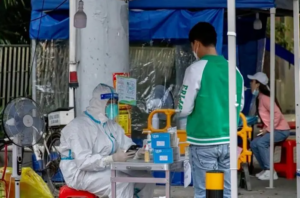
Liang Wannian: the new crown transferred to category B B management is not a laissez-faire, the local area has not been a large area of serious illness death
The joint prevention and control mechanism of the State Council released yesterday (26th) the “general plan on the implementation of “Category B B control” of novel coronavirus infection”. The program points out that China has the basic conditions to adjust the new coronavirus infection from “category B A management” to “category B B management”.
China’s infectious disease prevention and control according to the implementation of classification management, dynamic adjustment
The program requires adjustment of the population testing strategy, community residents according to the need to “test as much as possible”, no longer carry out full nucleic acid screening, graded classification and treatment of patients.
So, what is the main basis for adjusting the new coronavirus infection from category B infectious disease management according to category A to category B infectious disease management according to category B? Why would such an adjustment be made at this time? The reporter recently interviewed Liang Wannian, head of the expert group of the National Health and Wellness Commission’s Leading Group for New Coronavirus Epidemic Response.

Liang Wannian introduced that there are currently forty types of statutory infectious diseases in China, including two types of infectious diseases in category A, 27 types of infectious diseases in category B and 11 types of infectious diseases in category C.
Category A infectious diseases include plague, cholera. After the occurrence of such infectious diseases, the time limit for reporting the epidemic, the isolation of patients and pathogen carriers, the way of treatment, and the treatment of epidemic sites and areas are mandatory.
Category B infectious diseases, including the new crown, SARS, AIDS, viral hepatitis, etc., require strict control measures.
Category C infectious diseases are infectious diseases under surveillance and management, including influenza, mumps, etc.
Classification and management has been the strategy for the prevention and control of infectious diseases in China, has been the implementation of dynamic adjustment, scientific management in accordance with the law has been the basic principle of China’s response to infectious diseases. The specific classification of an infectious disease as a statutory or non-statutory infectious disease, as which type of statutory infectious disease, is a comprehensive consideration of the characteristics of the pathogen, disease characteristics, the speed and scope of transmission, the risk to life and health, the socio-economic impact, as well as the immunity of the population, the health system’s ability to prevent, control and treat and other factors to make decisions, as these factors change, the classification of infectious diseases will make the corresponding adjustments As these factors change, the classification of infectious diseases will be adjusted accordingly, and the corresponding prevention and control strategies and measures will be optimized and adjusted accordingly.

Liang Wannian, head of the expert group of the National Health Commission’s Leading Group for New Coronary Epidemic Response: When the disease was discovered at an early stage, we did not know much about it, whether it was the characteristics of the virus or the epidemiological features of the disease, including the risk to life and health, and so on, plus we did not fully have effective resistance, such as the immunity of our population and so on. In this case, because of its rampant, sudden, so the country designated it as a category B infectious diseases, the implementation of category A management is very correct, and practice has also proved that this category B A management measures have achieved very good results, effective protection of the people’s lives and health. Now some of our key circumstances have changed, in this case, taking into account all factors, and in order to better integrate epidemic prevention and control and socio-economic development, better focus on key areas of prevention and control measures, more scientific prevention and control of the epidemic, so from “Category B A management” adjusted to The conditions for “Class B B” are already in place.
Adjustment to category B B management is not to let go of
Some people think that adjusting to category B B control means lower prevention and control efforts, so what is the focus of China’s epidemic prevention and control at this time? Liang Wannian also responded to these concerns.

The purpose of the adjustment is to prevent and control the epidemic more precisely and scientifically, and to balance the epidemic prevention and control with socio-economic development by using relevant resources more effectively. We decided to adjust a certain prevention and control strategy and measures, including the adjustment of infectious diseases from “Category B A” to “Category B B”, always adhering to a philosophy, or the people first, life first, this is not changed, so we can not take it Therefore, we can not interpret it as from “Class B A” to “Class B B”, is to let go of.
Liang Wannian said, of course, after adjusting to category B management, in the quarantine of infected people and close contacts, the infected area closed, transport health quarantine and other preventive and control measures will make corresponding adjustments. Three years after the outbreak, we have been and are now actively preparing for these risks to ensure a smooth transition of the adjustment.

Liang Wannian, head of the expert group of the National Health and Wellness Commission’s Leading Group for the Response to the New Crown Epidemic: It is important to be confident and to protect people’s lives, health and physical safety to the greatest extent possible, so confidence is particularly important. From the domestic situation, some places have already passed or are passing the impact of our first wave of the highest peak, and there is no such situation as the death of a large area of serious illness that we are afraid of, which tells us to have confidence. This tells us that we should have confidence. Now I also have a deep feeling that the Chinese people are working together with our government and our departments to fight against the rise and spread of the epidemic. In addition, I think the first wave of this short period of transmission, we still need to focus on the scientific strengthening of disease surveillance, to see its variability, we still need to continue to strengthen.


Average Rating